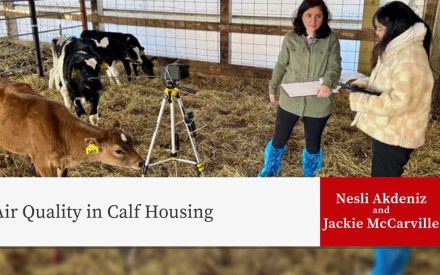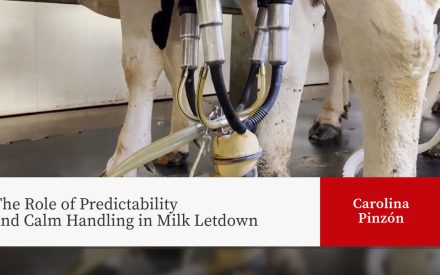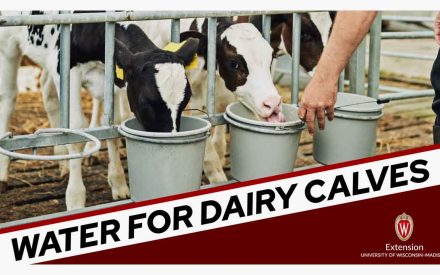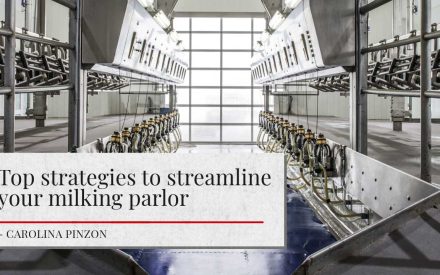Managing heat stress in dry cows is just as important as it is for lactating cows because it determines the amount of productivity and success a cow will have during her lactation. It can also influence the future success of the daughters and granddaughters of the dry cow.
Nutrition
Making major dietary changes is not recommended as the dry cow may not have time to adjust to the ration changes in a shorter period of time. Nutritional management during the dry period is extremely important.
Keeping them on feed will reduce incidence or prevent metabolic issues after calving. During the heat it is recommended to increase the number of times feed is delivered at the bunk. By doing this less feed is put in the bunk at a time which helps minimize spoilage and overheating of the feed.
Providing 30-36 inches of bunk space for transition cows and 18-24 inches for dry cows will also help to make sure dry cows are staying on feed. Cows may also change their eating patterns and have decreased feed intake.
Feed sorting can also be an issue when it is hot out so making sure the TMR is mixed well and particle length is adequate will help reduce sorting. Having the dry cow ration balanced for the proper nutrient levels at lower feed intakes is crucial in that it can help prevent metabolic issues later in the dry period or early lactation.
Having a clean reliable water source for dry cows is important. It has been shown that when temperature increased from 64 to 86 degrees, water intake went up 29%. It is advised to have a waterer per 15-20 head, and frequent cleaning.
Heat abatement
Heat abatement is important for dry cows in both buildings and on pasture. In barns, make sure each dry cow has a stall or 100 square feet of bedded pack. It is extremely important to place fans above the feed bunk and freestalls or bedding pack to achieve air velocities of at least 2½ mph, but ideally of 4-6 mph. Soaking dry cows at the feed bunk has also been shown to help with heat stress and is economically beneficial. For more on cooling cows in dairy facilities, see Heat Stress Abatement in Dairy Facilities.
If dry cows are on pasture, they should have at least 65 square feet per cow under a shade structure at least 12-16 feet tall in a non-muddy location. Mud pits can lead to environmental bacteria infections and severely decrease lying time. There are also water sprinklers that can be set-up for dry cows on pasture. If the dry cows are fed out on pasture, feed should be in a shaded location to prevent spoilage. For more information, see Dealing with Hot Weather in Pasture/Grazing Systems.
Animal Handling
Moving dry cows during hot weather should be considered. It is easier to move them early in the day when the temperature is lower. Also, they should be moved short distances when it is hot out. For more tips on animal handling during hot periods, please refer to Animal Handling During Heat Stress.
Transition Period
Fresh cows are already dealing with enough changes and a weakened immune system due to calving. If they must deal with heat stress on top of calving, they will have a greater risk of infection.
Transition cows that are dealing with heat stress tend to calve 2-8 days earlier and give birth to a calf that is around 13 pounds lighter. These calves continue to have lower body weight and height for their first year of life. These heat stressed calves also produce around 11 pounds less milk than ones born from a dam without heat stress. Heat stressed dry cows mean that the in-utero calves are also experiencing heat stress which appears to prevent optimal mammary gland development, thus leading to less milk production down the road for daughters and granddaughters of these dry cows.
Mammary Epithelial Cell Turn-overs
Mammary cell turn-over in dry cows can be affected by heat stress. The mammary gland development during the dry period is typically divided into 2 phases: mammary involution (characterized by cell death mechanisms to remove old worn-out cells) and mammary redevelopment (characterized by cell proliferation which helps to replenish the gland with new cells). Heat stress directly impairs mammary gland involution and mammary redevelopment.
At the onset of lactation, the capacity of the mammary gland to synthesize and store milk will depend on the number of mammary cells and the secretory activity of those cells.
When cows are heat stressed during the dry period, they exhibit carry-over effects in the next lactation evidenced by altered mammary gland tissue microstructure. These cows have fewer alveoli (secretory unit) and more connective (non-secretory) in their mammary glands compared to cooled cows. These cellular, histological, and molecular alterations induced by dry period heat stress can lead to a less productive gland with reduced synthetic capacity that ultimately results in milk production losses.
References:
- Water Needs and Quality Guidelines for Dairy Cattle AS1369. J.W. Schroeder Extension Dairy Specialist North Dakota State University.
- The Dairyland Initiative
- Ouellet V, Laporta J, Dahl GE. 2020. Late gestation heat stress in dairy cows: Effects on dam and daughter. Theriogenology 150:471e479. https://doi.org/10.1016/j.theriogenology.2020.03.011
- Wohlgemuth SE, Ramirez-Lee Y, Tao S, Monteiro APA, Ahmed BM, Dahl GE. Short communication: effect of heat stress on mammary gland autophagy during the dry period. J Dairy Sci. 99:4875e80. https://doi.org/10.3168/jds.2015-10649.
- Tao S, Bubolz JW, do Amaral BC, Thompson IM, Hayen MJ, Johnson SE, Dahl GE. 2011. Effect of heat stress during the dry period on mammary gland development. J Dairy Sci 94:5976e86. https://doi.org/10.3168/jds.2011-4329.
- Dado-Senn B, Skibiel AL, Fabris TF, Dahl GE, Laporta J. 2019. Dry period heat stress induces microstructural changes in the lactating mammary gland. PloS One 4:e0222120. https://doi.org/10.1371/journal.pone.0222120.
- Dado-Senn B, Skibiel AL, Fabris TF, Zhang Y, Dahl GE, Penagaricano F, Laporta J. 2018. RNA-seq reveals novel genes and pathways involved in bovine mammary involution during the dry period and under environmental heat stress. Sci Rep. 8:11096. https://doi.org/10.1038/s41598-018-29420-8.
- Late-gestation heat stress impairs daughter and granddaughter lifetime performance J. Laporta,1 * F. C. Ferreira,2 V. Ouellet,1 B. Dado-Senn,1 A. K. Almeida,1 A. De Vries,1 and G. E. Dahl1 1 Department of Animal Sciences, University of Florida, Gainesville 32611 2 Veterinary Medicine Teaching and Research Center, School of Veterinary Medicine, University of California, Davis, Tulare 93274 J. Dairy Sci. 103 https://doi.org/10.3168/jds.2020-18154
Download Article

 Air Quality in Calf Housing
Air Quality in Calf Housing The Role of Predictability and Calm Handling in Milk Letdown
The Role of Predictability and Calm Handling in Milk Letdown The importance of water for dairy calves
The importance of water for dairy calves Top strategies to streamline your milking parlor
Top strategies to streamline your milking parlor


